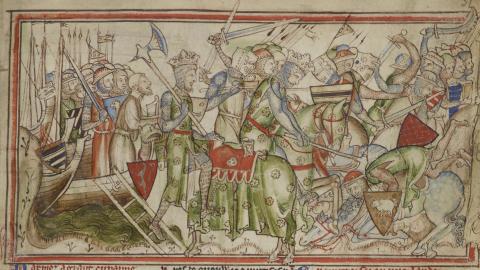The lives of the Suffragettes
It was on 8 June 1913 that the most infamous moment in the history of the suffragette movement occurred in front of spectators at the Derby horse race. Emily Davison, a former governess and academic, stepped out onto the course and was hit by King George V’s horse. Her injuries proved fatal, making her an enduring martyr to the cause, even though newspapers at the time condemned her as ‘malignant’, ‘grotesque’ and ‘miserable’.
That last adjective was accurate, at least. Davison had suffered the pain and anguish of being force-fed by authorities while on hunger strike in prison, and had previously attempted suicide. Another famous suffragette subjected to this kind of cruelty was Emmeline Pankhurst, the leader of the movement, who spoke of the ‘civilised torture of solitary confinement’, and described Holloway Prison as a ‘place of horror and torment’.
But, while the likes of Emily Davison and the Pankhurst dynasty are still synonymous with the suffragettes, the reality is the movement encompassed countless women whose names have been lost in time. In fact, many of us delving into our family trees on may be surprised to discover unsung suffragettes among our ancestors.
The movement had its roots in the Victorian era. An early champion of votes for women was the philosopher and politician John Stuart Mill, who published a famous essay advocating female suffrage in 1869. Even before that, though, an amateur scientist called Lydia Becker established herself as an influential activist, writing ‘if it be granted that women may, without offence, hold political opinions, on what ground can the right be withheld of giving the same expression or effect to their opinions as that enjoyed by their male neighbours?’
One of her associates was Dr Richard Pankhurst, a lawyer, socialist and advocate of women’s rights. His wife, Emmeline Pankhurst, would go on to form the Women's Social and Political Union in 1903. Eventually dubbed the ‘suffragettes’, Pankhurst and her activists were committed to militant action and civil disobedience. Their guiding principle was ‘deeds not words’, which distinguished them from the rival suffragist movement, which believed in bringing change only through peaceful, political campaigning.
'Mrs Pankhurst gave us strict orders… there was not a cat or a canary to be killed: no life.'
The suffragettes achieved notoriety through acts of arson and vandalism. Home-made bombs were planted at various sites across the country, including numerous churches, leading many to dub them terrorists. They were careful not to harm life, however. As one suffragette later said in an interview, ‘Mrs Pankhurst gave us strict orders… there was not a cat or a canary to be killed: no life.’
The suffragettes also had a respectable public profile that ran parallel to the explosive activism. They had their own branding and merchandise – department stores like Selfridges sold ribbons and clothes with the white, green and purple suffragette colours, and they even raised funds with sales of a board game called ‘Pank-a-Squith’, referencing Emmeline Pankhurst and the Prime Minister Herbert Asquith
People from all backgrounds and social classes joined the movement. Some deeply privileged women even reinvented themselves in the name of social justice. Take the example of Lady Constance Bulwer-Lytton. Uncomfortably aware of how well she was treated compared to other suffragettes, simply because of her aristocratic status, she took on an alternative identity by posing as an ‘ugly London seamstress’ called Jane Warton, and was subjected to force-feeding while on hunger strike.
One of her opposites on the social spectrum was Annie Kenney, who worked in a Yorkshire cotton mill as a child and rose up to become one of the most senior suffragettes from a working class background. Proud of leading ‘fishwives, East End women, laundresses, teachers, nurses’ to meet politicians, Annie Kenney found infamy in 1905 after disrupting a speech given by a young MP, Winston Churchill, and demanding to know his stance on women’s rights.
A particularly fascinating figure who unfairly fell into obscurity over time was Edith Garrud, who was one of the first female martial arts instructors in British history. ‘Physical force seems the only thing in which women have not demonstrated their equality to men,’ she once said, and did her bit to change that by teaching jujutsu to suffragettes. She trained the ‘Bodyguard’ – a special group of suffragettes who were tasked with protecting members of the movement and carried clubs hidden in their dresses.
Another name which deserves to be better known is Evaline Hilda Burkitt, who had the morbid distinction of being the first suffragette to be force-fed in prison. Hunger striking time and time again, she is thought to have been force-fed close to 300 times, yet remained stubbornly committed to the cause. She wrote a powerful letter to the Home Office asserting that she was willing to die ‘to bring about the freedom of my sex’. Fortunately, she survived and went on to make a living as a ‘confectioner and cake maker’.
Her act turned out to be a final, dramatic flourish for the suffragette movement
As for Emily Davison, her death at the Derby is still a subject of much debate. Did she deliberately take her own life? Known for direct action such as arson, and described by Sylvia Pankhurst as ‘one of the most daring and reckless of the militants’, Davison had certainly regarded suicide as a political weapon, and had once tried to kill herself by leaping from a prison balcony. ‘I felt that by nothing but the sacrifice of human life would the nation be brought to realise the horrible torture our women face,’ she wrote.
However, many have argued that her death at the Derby was accidental, suggesting her aim had actually been to attach a suffragette flag to the king’s horse. Whatever the truth of her motivations, her act turned out to be a final, dramatic flourish for the suffragette movement. With the outbreak of the Great War in the following year, the suffragettes suspended their activism to join the patriotic war effort. The radical social changes of those turbulent years led to a change in the law in 1918, with some (but not all) women being given the vote. It would be another decade before equal voting rights were finally granted.















